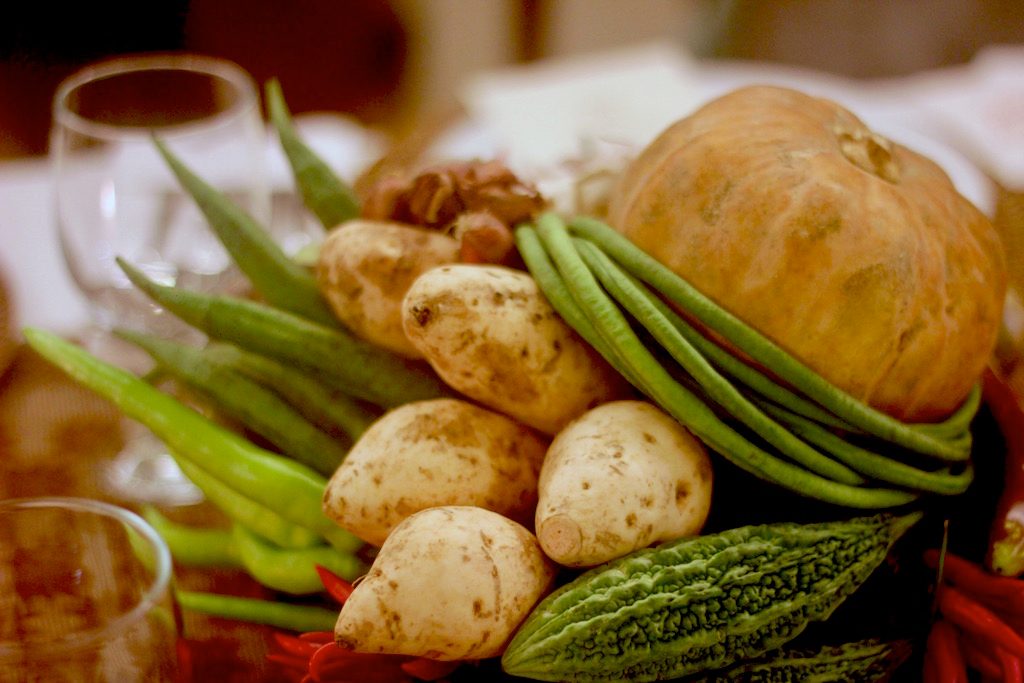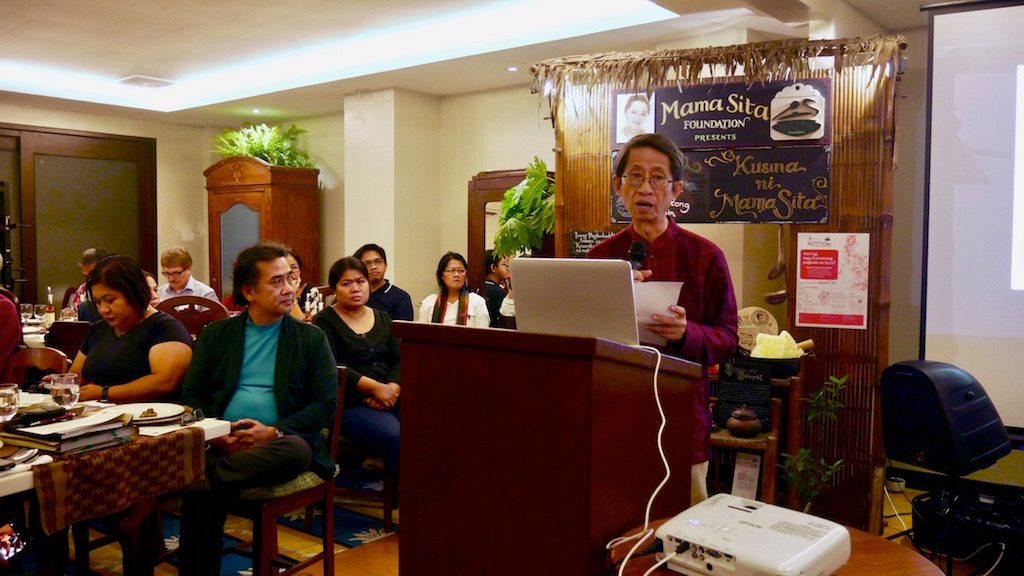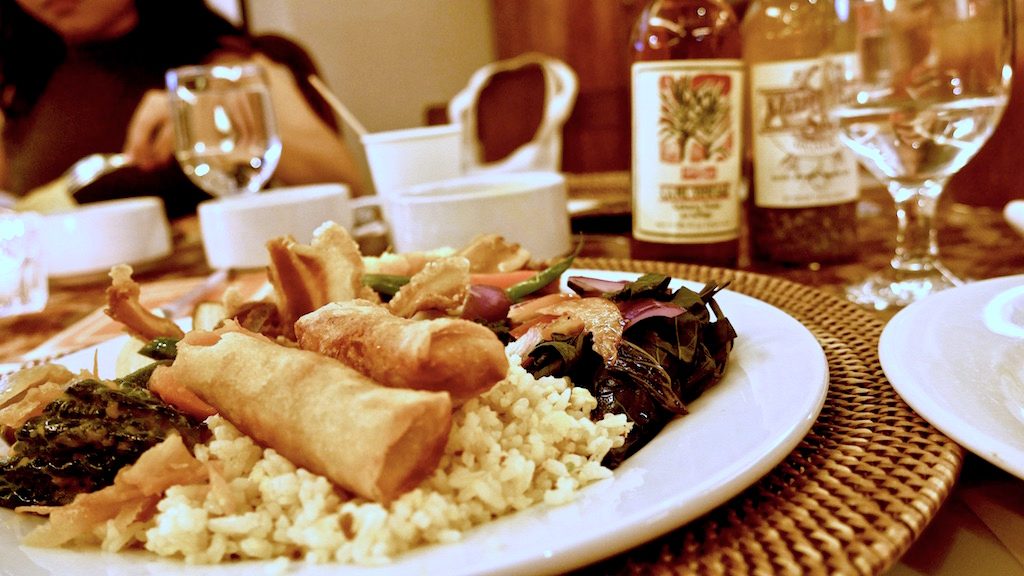SUMMARY
This is AI generated summarization, which may have errors. For context, always refer to the full article.

MANILA, Philippines – Sabrina works in a popular Vigan restaurant – serving the crunchiest bagnet, the most savory of pakbet, and steaming hot empanada. Closing shop and going home, however, brings a new set of aromas and flavors to her palate: fresh vegetables in various viands, boiled, thickened into soup, shrunken, stir-fried, and tossed into salad. At the heart of it all simmers one humble if ubiquitous ingredient: the unassuming camote (sweet potato).
From farm to table
Camote, both significant and obscure, is prominent in everyday cooking in Ilocos but not normally associated with the cuisine by outsiders. This was what led Dr. Fernando Zialcita of the Ateneo de Manila University’s Ateneo Culture Lab (ACL) to partner with Victorino’s restaurant and the Mama Sita Foundation (MSF) for a study which culminated in the October 25 dinner.
An old recipe notebook started it all. Congressman Victor Savellano, who advocates Ilocano heritage and culture, finds his passion striking a chord with his mother Virginia’s recipes. He would eventually turn his family house into one of the Metro’s most iconic Ilocano restaurants: Victorino’s.
Last October 25 witnessed an Ilocano take on popular dishes by the restaurant’s chef Heny Sison. From appetizer to dessert, each course featured camote as a recurring ingredient: A salad of camote tops, a creamy soup, wrapped in lumpia, a thickening agent to pakbet, mashed and partnered with roast beef, and even candied in muscovado and dressed in sesame seeds.
This served as a teaser for a book co-authored by Savellano and Sison, Naimas! The food heritage of Ilocos Sur, also containing Virginia Savellano’s camote recipes.

This year’s dinner focused on Ilocandia’s contribution to reducing our collective carbon footprint, thus the theme: Ilocano Dishes for A Warmer Planet. The province’s weaving and jewelry was also featured.
Beyond Ilocandia’s most visible dishes lie recipes that, apart from striking that oft-sought balance between healthful and flavorful, may just have implications for the diets of the future.
From field to nation
Last June and July, students and professors, guided by Zialcita and Nota Magno, trooped to Vigan and the northern towns of Ilocos Sur. They sought to unearth the everyday, oft-overlooked facets of life and in the process found insights not just for commerce and cuisine, but for food security and even issues like global warming.
Students discovered that popular meat dishes like bagnet, igado, and empanada are only served on occasions like fiestas and weddings. For most of the year, Ilocanos find their staple in vegetables, paired with fish, meat, or just rice.

Sociologist and think-tank executive Emma Porio linked their findings to hers – the realization that camote and root crops can serve as post-calamity food, replacing canned goods and cup noodles. Thinking further ahead, it was also suggested that such a diet could also prevent disasters.
The popularization and consequent tourist demand for seasonal dishes by restaurants in provinces has been pointed out by both Zialcita and Porio as one cause of global warming: a year-round, 24/7 demand for ingredients requiring much resources to grow.
A humble crop
Zialcita revealed that rice is seen as “premium” in most of East Asia while root crops are seen as “low-class,” pedestrian: “nangangamote,” the professor quips. He hopes that chefs and entrepreneurs will contribute to changing this perception.
This echoes with Western Europe’s relationship with barley and white potatoes. When the latter was first imported to the continent, it was considered lowly and suspected as poisonous. Eventually, French chefs spun and popularized the root crop, making it a European staple as it was easier to grow.
Barley, like rice, is more expensive to cultivate. Zialcita and Porio envision a Filipino diet not necessarily Ilocano, but nonetheless as nutritious and energy-efficient. As for the notorious “popping balloons” linked to camote consumption, Zialcita assured diners that this was really just the body adapting to a high-fiber diet: the pops eventually stop if one keeps up.
Tied together
The dinner also turned the spotlight on the jewelry and textiles of Ilocos Sur. For the weavers of the traditional binakul, the patterns are more than a style statement, but represent themes like life, death, healing, and nature.

Meanwhile, the jewelry, commonly shaped as earrings called tamborine, is traditionally handcrafted from mainly gold and silver. The composite beads can be strung to form necklaces too. The tradition dates back to pre-Hispanic times, when gold was more abundant in the islands.
Both find challenges today amidst mass-produced fashion. The idea that traditional textiles and jewelry are backward is prevalent among younger Ilocanos. In the same way, their diets have shifted lately from mostly vegetable-based to meat-and-fastfood heavy.
Sailing ahead
Ultimately, Dr. Zialcita hopes that the struggles faced by cultural heritage today amidst the changing attitudes are not as black-and-white. Like the binakul weavers, tamborine makers, and farmers continuing to grow vegetables, the anthropologist maintains that these can be popularized again if done well. He hopes young, homegrown entrepreneurs will see the region’s potential.

Having demonized business in his younger days, Zialcita now sees the power of good marketing, helmed by proprietors for whom profit is not the sole objective. He sees efforts such as the collaboration between ACL and MSF as steps forward in embracing change while still being nourished by one’s roots. He believes that the “good aspects of certain cultures” can offer solutions to today’s issues.
He believes that there will always be one or two enthusiastic, like-minded individuals taking up the reins of their forebears, and that their choices will eventually let their paths cross, creating momentum. The presence of students, as well as their mentors and guests at Victorino’s show that such a movement isn’t just a trickle, but a river rushing to the ocean. – Rappler.com
Follow the author on Twitter @peaveyvee and Instagram.com/_peaveyvee
Add a comment
How does this make you feel?
There are no comments yet. Add your comment to start the conversation.